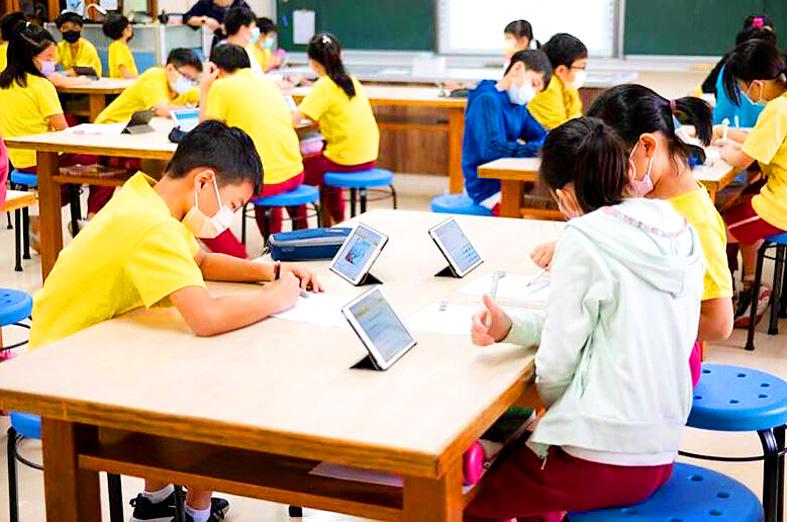A stronger focus is to be put on digital education when the new semester begins in September, the Ministry of Education told Premier Su Tseng-chang (蘇貞昌) in a Cabinet meeting yesterday.
The ministry has set aside NT$20 billion (US$668.3 million) over the next four years to purchase 61,000 tablet computers for elementary and junior-high schools, it said, adding that the plan is part of the Executive Yuan’s digital education initiative.
The plan comes after it allocated NT$1.5 billion from 2017 to 2025 to improve high-speed Internet access at schools and install equipment for smart classrooms, the ministry said.

Photo courtesy of the Minsitry of Education
Supported by the Public Construction Commission, the ministry in March held an open bid, it said, adding that it chose a bidder in April and placed an order in May.
In addition to hardware, such as learning and charging devices, the project also focuses on enriching digital learning materials, it said.
The government has worked with the private sector to develop quality teaching materials and provided subsidies for schools to purchase the materials they needed, the ministry added.
With the help of the Institute for Information Industry, the ministry on June 1 published a list of 762 products from 84 companies for local governments and schools to choose from, it said, adding that it would publish a second list in September.
The ministry said it has held advisory meetings in which experts and academics shared their opinions on setting up a portal for digital learning that would integrate resources suitable for elementary school and junior-high school students from Taiwan and abroad.
Teachers and students can from next month use their education Open IDs to log in and use the resources on 52 free teaching or learning platforms, the ministry said, encouraging them to “like” and share the materials on social media.
The ministry also launched the E-Learning Gateway artificial intelligence learning platform, which uses big data to analyze students’ weaknesses and help them learn more efficiently, it said, adding that it did so in line with global trends in the education sector.
The results of national examinations, including the Project for Implementation of Remedial Instruction Technology-based Testing and local academic competence tests, showed that digital learning can significantly improve learning outcomes, it said.
To alleviate job market shortages, the ministry fully subsidized local governments to set up digital learning offices and provided financial support for schools to hire additional dedicated staff, it said.
The ministry prepared plans for teacher training, in which they would learn about the concepts and methods of using digital tools in the classroom, it said.
The ministry would continue to allocate resources to narrow the urban-rural gap in education and provide “borderless” digital learning classrooms, it said.

SHIPS, TRAINS AND AUTOMOBILES: The ministry has announced changes to varied transportation industries taking effect soon, with a number of effects for passengers Beginning next month, the post office is canceling signature upon delivery and written inquiry services for international registered small packets in accordance with the new policy of the Universal Postal Union, the Ministry of Transportation and Communications said yesterday. The new policy does not apply to packets that are to be delivered to China, the ministry said. Senders of international registered small packets would receive a NT$10 rebate on postage if the packets are sent from Jan. 1 to March 31, it added. The ministry said that three other policies are also scheduled to take effect next month. International cruise ship operators

NUMBERS IMBALANCE: More than 4 million Taiwanese have visited China this year, while only about half a million Chinese have visited here Beijing has yet to respond to Taiwan’s requests for negotiation over matters related to the recovery of cross-strait tourism, the Tourism Administration said yesterday. Taiwan’s tourism authority issued the statement after Chinese-language daily the China Times reported yesterday that the government’s policy of banning group tours to China does not stop Taiwanese from visiting the country. As of October, more than 4.2 million had traveled to China this year, exceeding last year. Beijing estimated the number of Taiwanese tourists in China could reach 4.5 million this year. By contrast, only 500,000 Chinese tourists are expected in Taiwan, the report said. The report

The Forestry and Nature Conservation Agency yesterday launched a gift box to market honey “certified by a Formosan black bear” in appreciation of a beekeeper’s amicable interaction with a honey-thieving bear. Beekeeper Chih Ming-chen (池明鎮) in January inspected his bee farm in Hualien County’s Jhuosi Township (卓溪) and found that more than 20 beehives had been destroyed and many hives were eaten, with bear droppings and paw prints near the destroyed hives, the agency said. Chih returned to the farm to move the remaining beehives away that evening when he encountered a Formosan black bear only 20m away, the agency said. The bear

HORROR STORIES: One victim recounted not realizing they had been stabbed and seeing people bleeding, while another recalled breaking down in tears after fleeing A man on Friday died after he tried to fight the knife-wielding suspect who went on a stabbing spree near two of Taipei’s busiest metro stations, Taipei Mayor Chiang Wan-an (蔣萬安) said. The 57-year-old man, identified by his family name, Yu (余), encountered the suspect at Exit M7 of Taipei Main Station and immediately tried to stop him, but was fatally wounded and later died, Chiang said, calling the incident “heartbreaking.” Yu’s family would receive at least NT$5 million (US$158,584) in compensation through the Taipei Rapid Transit Corp’s (TRTC) insurance coverage, he said after convening an emergency security response meeting yesterday morning. National